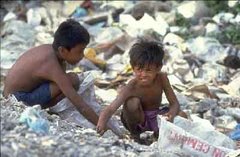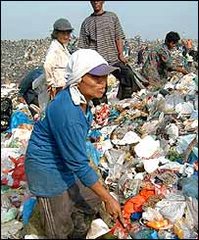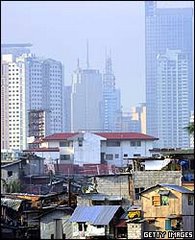Introduction
The Philippines, made up of a group of many islands, is a land of considerable beauty yet there are many contrasts. The country's wealth is not evenly distributed and a large percentage of the people live in poverty. In 1991, 40 percent of households lived in poverty. This has fallen to 32 percent in 1997 (World Bank, 2000). This still equates to millions of people living in urban slums or in rural areas that lack sanitation, safe water and other services that we take for granted. The challenge is to reduce poverty in light of a rapidly growing population.
Due to the poverty and lack of opportunities in rural areas, each year many people migrate to the cities looking for better economic opportunities. Most families are impoverished and children are often forced to earn an income. The types of jobs include selling items such as newspapers, cigarettes and lollies, or odd jobs such as car-washing, hauling or domestic work. Other possibilities include working in factories, construction sites, ports or small backyard industries, while some resort to scavenging or begging. The following are two examples of the lives of street and urban children in the Philippines.
Julie
Julie is a 10 year old girl who lives in Manila with her family. Julie's father is unemployed and her mother sells flowers in clubs near their home. Being the youngest of six children in her family, she has always accompanied her mother selling flowers from 10pm till 5am. Julie has been exposed to this lifestyle since she was five years old. Living in poverty has forced Julie to resort to the same job of selling flowers and key chains like her mother. Julie is exposed to drunks and street fighting as she sells her goods on the streets during the night.
Evelyn
Evelyn and her family migrated to Manila from the island of Samar when she was six years old. Evelyn, being the third of six children, came with her parents to Manila looking for better economic opportunities. Her father has irregular work as a jeepney driver while her mother is a market vendor. Evelyn and her older siblings were forced to work due to poverty and her parents unstable income.
Living conditions
Each year more people migrate from rural areas to the cities looking for better economic opportunities. Families come hoping that they can find a better lifestyle. Most have low education levels and lack marketable skills. Consequently they find it difficult to find ongoing stable employment. As a result they usually end up living in blighted areas.
Families rely on makeshift housing.
Under bridges, beside rivers, adjacent to landfills and near railways are just some examples of sites where these poverty stricken families may reside when they first come to the cities. Houses may be made from cloth, cardboard, corrugated iron, scrap wood, boxes, tarpaulins and rope. Living conditions are usually very poor, the areas are overcrowded, shelter is temporary and insubstantial and there can be a lack of basis needs such as water and sanitation. Access to health services is usually very poor or non-existent.
Impact on health
Children working on the streets are exposed to many hazards. Children who spend many hours working on the street are more susceptible to respiratory infections, pneumonia and other illnesses, and face a high risk of injury or death from motor vehicles. They can be used as accessories in drug deals, robberies, swindling and extortion. Some are even forced into child prostitution or other criminal activities.
Education
Street children often face difficulties in gaining an education and leaving the streets for the following reasons: they have limited access to quality education available in the areas where they live and work; irregular or low family incomes cannot cover the costs of school enrolment, uniforms and school projects; and
once enrolled in school, a high proportion of these children are forced to drop out, especially as school expenses rise in later years.
In the long term there is little chance of these children gaining meaningful employment, leaving the streets and breaking the cycle.
The Street and Urban Working Children Project
The Philippines' Government targeted street children and their parents as a vulnerable group that needed greater attention. In 1994 the Department of Interior and Local Government, with funding assistance from the Australian Government's overseas aid program, embarked on a five year project called The Street Children Nutrition and Education Project. Today this project continues as the Street and Urban Working Children Project.
The target group for this project are street and urban working children and their families. They are defined as: children aged 5 to 17 years old; children of urban impoverished families who spend a significant amount of time on the streets, usually not protected, supervised or cared for by responsible adults; those who have adopted the streets for their living and/ or source of livelihood; those who are street/community based and working, either in or out of school; those who have already been taken away from the streets but still need continued rehabilitation and care.
It should be noted that the vast majority of street and urban working children do live at home with a family, however the time they spend with the family may be minimal.
Project strategies
It is 7am and the non government organisation (NGO) bus pulls up in one of the poorer neighbourhoods in Manila. They load up the bus with children to take to the Old Fortress for the day. Arriving at the fortress there is a large grassed area at the front set up with tables and chairs where the children will spend the day. They will do basic schooling, literacy and numeracy and take part in value formation classes. At the end of the day each child will take home 1.5kg of rice as an incentive to return.
This is an example of how the project works in one area of the Philippines. In other areas children participate in vocational training including some income generating activities with money being passed on to the children. The aim is to increase their skills for future paid employment when they are older.
Parents of these children are also encouraged by the rice incentive to attend value formation classes for adults. The content of these classes includes the importance of health and education, caring and nourishment for their children, family values and morals, and the importance of keeping the children off the streets.
For the whole family the hope is with education and training, there will be improved access to economic opportunities and to social services. The schooling, vocational training and interaction with the NGO are all hoped to generate an increased level of participation in the community and ultimately to keep the children from working on the streets.
Another objective of the project is construct social development centres in each Local Government Unit (LGU) to effectively deliver social services now and help sustain the project after its termination.
Street Children Nutritional and Education Project
The rice has increased school attendance and improved the quality of participation at school.
The rice provided sufficient incentive for parents to regularly attend value formation training programs.
over 6,100 children reduced the time spent on the streets by 20% or more, and more than 2,600 children had been drawn from the streets completely.
What is life like today for Julie and Evelyn?
Julie
Julie is a bright and diligent student who was given the opportunity to be part of the project receiving rice, school supplies and a school scholarship. Julie dreams of becoming a nurse, "to help her family and the poor and sick people". She believes her dream will come true with the assistance from the project. The rice assistance and school scholarships have inspired her to study harder.
Evelyn
Evelyn now receives regular supplies of rice which has enabled her to concentrate more on her studies. The rice assistance has supplemented the families food, allowing money that would have been spent on rice to be spent on school projects. Evelyn is an active and diligent student who excels in her class and is determined to finish her schooling, and become a teacher to serve the poor and special children like her.
--------------------------------------------------------------------------------
Top
© Commonwealth of Australia
Subscribe to:
Post Comments (Atom)








2 comments:
Whew! :’( What a very heartbreaking realities being faced. But on the other hand, I am relieved knowing that the government has continually focused some programs and projects that cater the needs of the needy, likewise to some NGOs in order to somehow augment their living conditions. And also to some people like you who work for the same purpose. I pray that it will be sustained and will be properly responded by its beneficiaries.
I enjoy reading this blogged item and the like. It has factual realities that awakens my social responsibilities to others.
Post a Comment